Valdosta, Georgia
In This Document
Summary
The quality of water in the Upper Floridan aquifer near Valdosta, Georgia is affected locally by discharge of Withlacoochee River water through swallow holes and sinkholes in the river bed. Data on transient tracers and other natural substances, including dissolved chloride (Cl-), tritium (3H), tritiogenic helium-3 (3He), chlorofluorocarbons (CFC-11, CFC-12, CFC-113), dissolved organic carbon (DOC), dissolved oxygen (DO), dissolved hydrogen sulfide (H2S), dissolved methane (CH4), oxygen-18 (δ 18O), deuterium (δ D), and carbon-14 (14C) were investigated as tracers of Withlacoochee River water in the Upper Floridan aquifer. The concentrations of all tracers were affected by dilution and mixing. Dissolved Cl-, δ 18O, δ D, CFC-12, and the quantity (3H+3He) are stable in water from the Upper Floridan aquifer, whereas DOC, DO, H2S, CH4, 14C, CFC-11, and CFC-113 are affected by microbial degradation and other geochemical processes occurring within the aquifer. Groundwater mixing fractions were determined by using dissolved Cl- and δ 18O data, recognizing three end-member water types in the groundwater mixtures: (1) Withlacoochee River water (δ 18O=-2.5±0.3 per mil, Cl-=12.2±2 mg/L), (2) regional infiltration water (δ 18O=-4.2±0.1 per mil, Cl-=2.3±0.1 mg/L), and (3) regional paleowater resident in the Upper Floridan aquifer (δ 18O=-3.4±0.1 per mil, Cl-=2.6±0.1 mg/L) (uncertainties are ± 1s ). Error simulation procedures were used to define uncertainties in mixing fractions. Fractions of river water in groundwater range from 0 to 72 percent and average 10 percent. The influence of river-water discharge on the quality of water in the Upper Floridan aquifer was traced from the sinkhole area on the Withlacoochee River 25 km southeast in the direction of regional groundwater flow. Infiltration of water is most significant to the north and northwest of Valdosta, but becomes negligible to the south and southeast in the direction of general thickening of post-Eocene confining beds overlying the Upper Floridan aquifer.
Tritium/helium-3 (3H/3He) and chlorofluorocarbon (CFCs, CFC-11, CFC-12, CFC-113) data were used to date the young fraction in groundwater mixtures from a karstic limestone aquifer near Valdosta, Georgia, where regional paleowater in the Upper Floridan aquifer receives recharge from two young sources-- flow of Withlacoochee River water through swallow holes and sinkholes in the river bed, and leakage of infiltration water through post-Eocene semi-confining beds above the Upper Floridan aquifer. In dating the young fraction of mixtures using CFCs, it is necessary to reconstruct the CFC concentration that was in the young fraction prior to mixing. The 3H/3He age is independent of the extent of dilution with older (3H-free and 3Hetrit-free) water. The groundwater mixtures were designated as Type-1 for mixtures of regional paleowater and regional infiltration water and Type-2 for mixtures containing more than approximately 4 percent of river water. The fractions of regional paleowater, regional infiltration water, and Withlacoochee River water in the groundwater mixtures were determined from Cl- and δ 18O data for water from the Upper Floridan aquifer at Valdosta, Georgia (Plummer et al., 1998).
The chlorofluorocarbons CFC-11 and CFC-113 are removed by microbial degradation and/or sorption processes in most anaerobic (Type-2) groundwater at Valdosta, but are present in some aerobic Type-1 water. CFC-12 persists in both sulfate-reducing and methanogenic water. The very low detection limits for CFCs (approximately 0.3 pg kg-1) permitted CFC-11 and CFC-12 dating of the fraction of regional infiltration water in Type-1 mixtures, and CFC-12 dating of the river-water fraction in Type-2 mixtures. Overall, approximately 50 percent of the 85 water samples obtained from the Upper Floridan aquifer had CFC-12-based ages of the young fraction that were consistent with the 3H concentration of the groundwater. Because of uncertainties associated with very low tritium and 3He content in dilute mixtures, 3H/3He dating was limited to the river-water fraction in Type-2 mixtures containing more than about 10 percent river water. Of the 41 water samples measured for 3H/3He dating, dilution of 3H and low 3H concentration limited 3H/3He dating to 16 mixtures in which 3H/3He ages were defined with errors ranging from 2 to 7.5 years (1 s ). After correction for dilution with (assumed) CFC-free regional infiltration water and regional paleowater in the Upper Floridan aquifer, adjusted CFC-12 ages agreed with 3H/3He ages within 5 years or less in 7 of the 9 co-dated Type-2 mixtures.
Tritium data and dating based on both CFC-11 and CFC-12 in Type-1 mixtures indicate that travel times of infiltration water through the overlying Post-Eocene semi-confining beds exceed 35 years. The CFC and 3H/3He dating indicate that the river fraction in most groundwater entered the groundwater reservoir in the past 20 to 30 years. Few domestic and municipal supply wells sampled intercept water younger than 5 years. Calculated velocities of river water in the Upper Floridan aquifer downgradient of the sinkhole area range from 0.4 to 8.2 m/d. Radiocarbon data indicate that ages of the regional paleowater is on the 10,000-year time scale. An average lag time of approximately 10 to 25 years was determined for discharge of groundwater from the surficial and intermediate aquifers above the Upper Floridan aquifer to the Withlacoochee River.
Photos:

Map showing apparent CFC-12 and 3h/3he ages of the predominant young fraction (river water or regional infiltration water) in groundwater mixtures from the Upper Floridan aquifer near Valdosta, Georgia (from Plummer et al., 1998b)
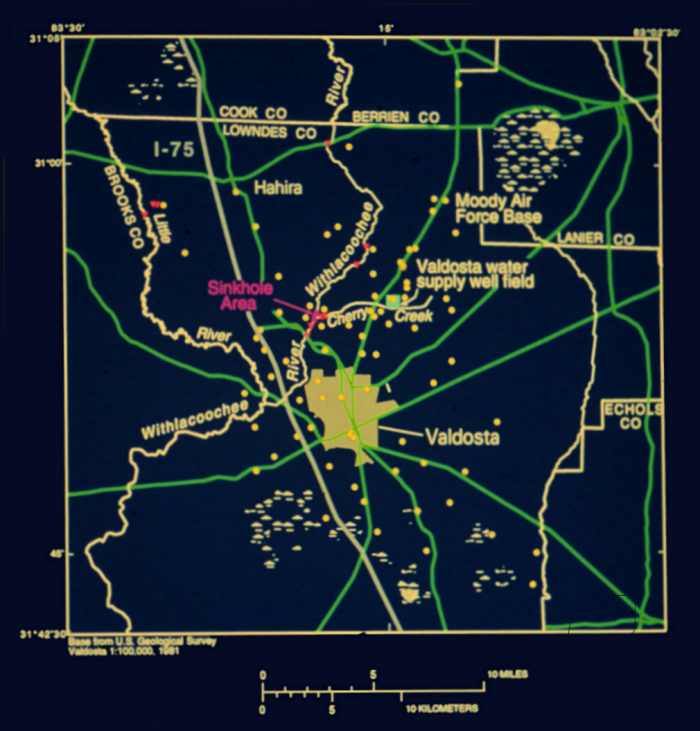
Location map for Valdosta, Georgia, and wells sampled
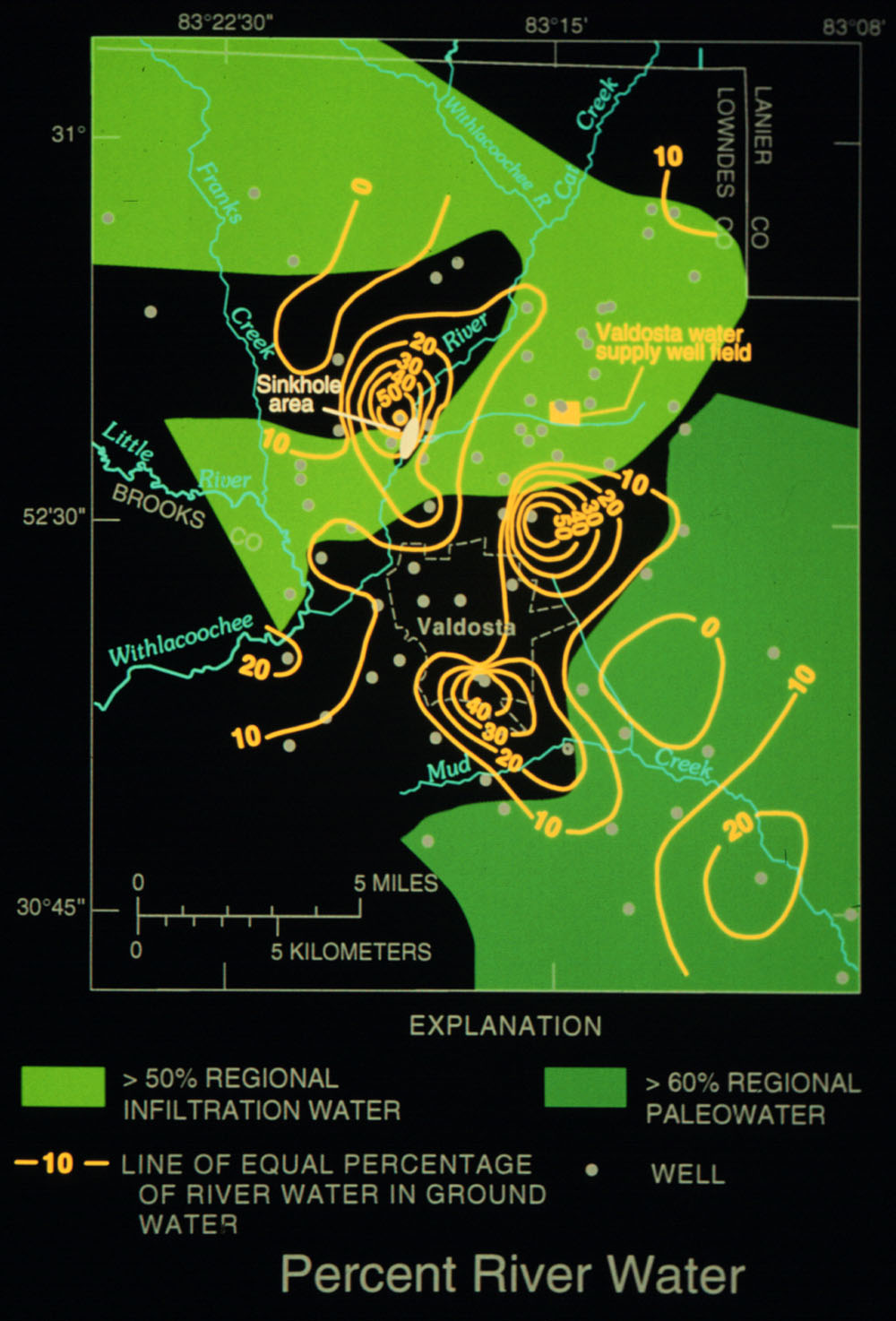
Map showing calculated percent of Withlacoochee river water in ground water
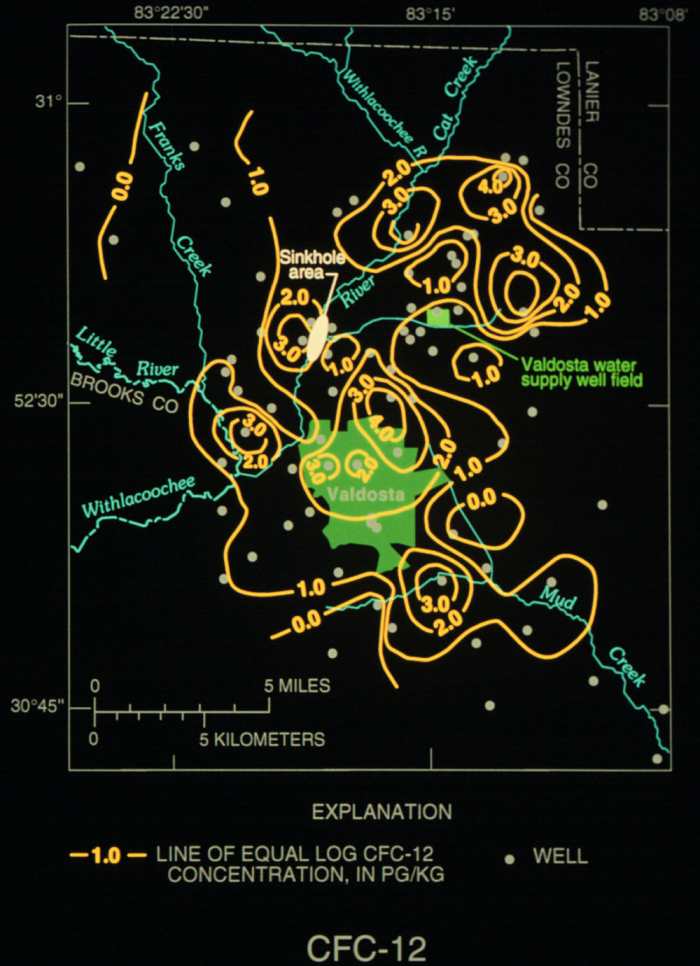
Map showing contours of CFC-12 concentration in ground water at Valdosta (as log pg/kg)
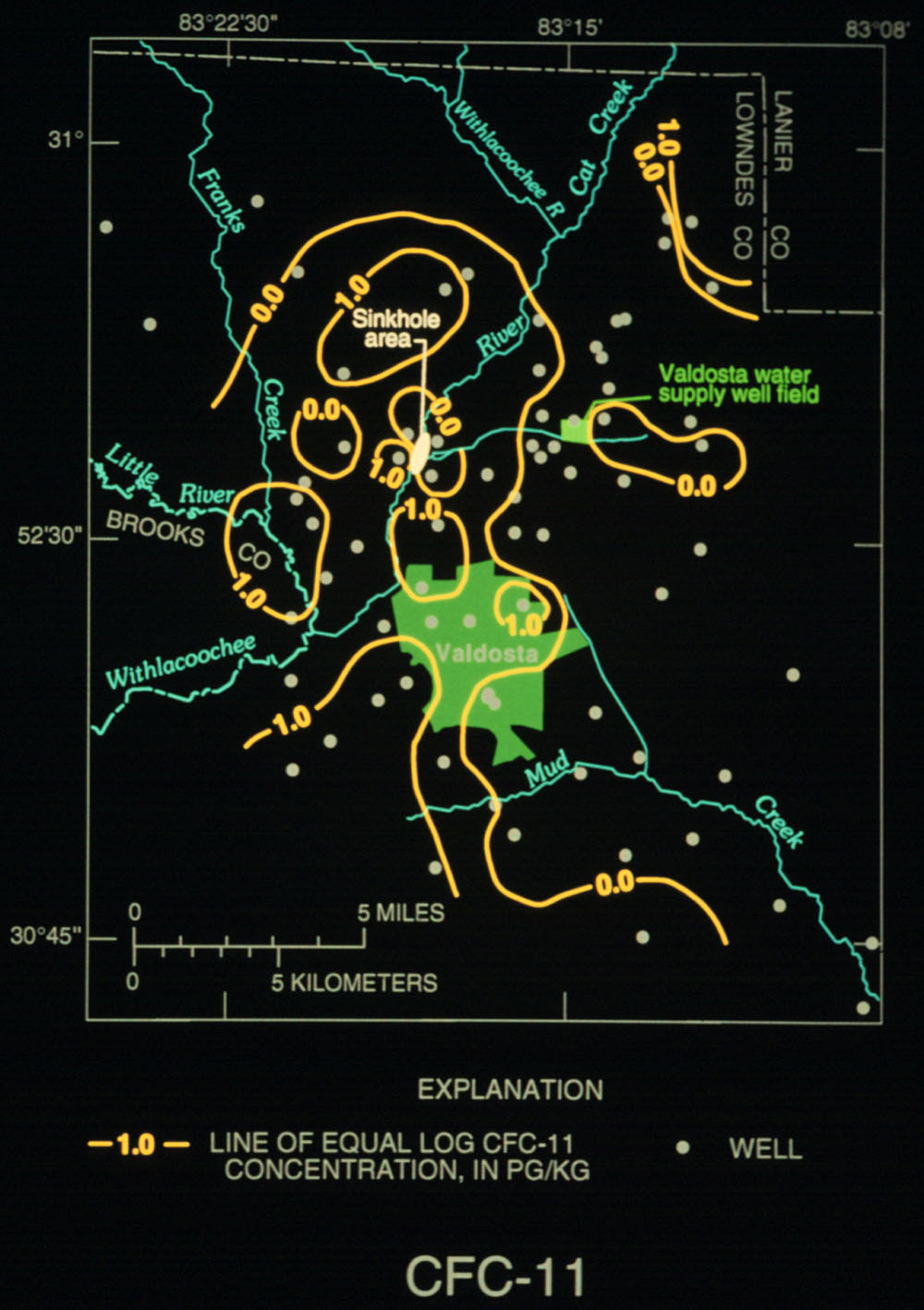
Map showing contours of CFC-11 concentration in ground water at Valdosta (as log pg/kg)
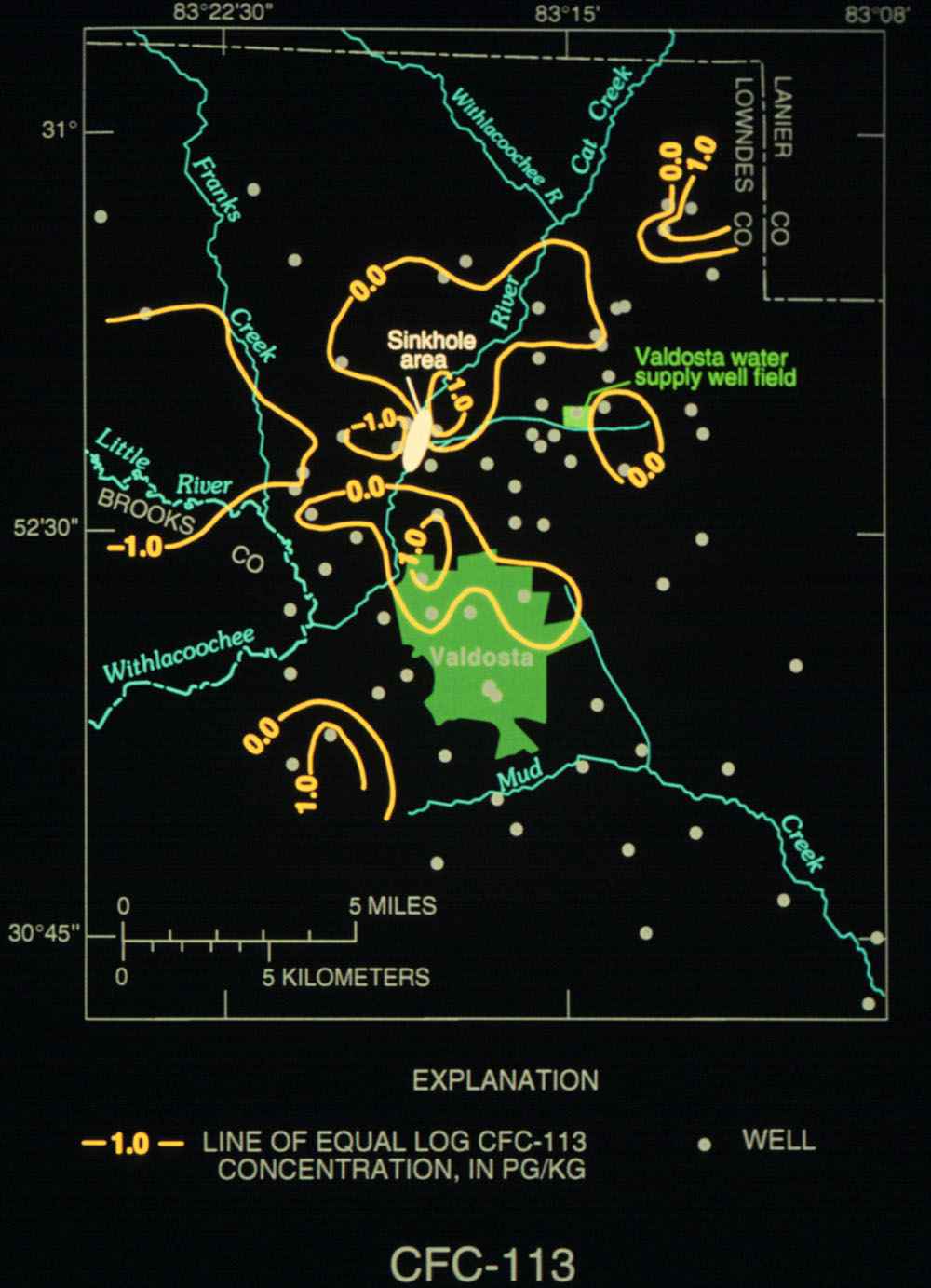
Map showing contours of CFC-113 concentration in ground water at Valdosta (as log pg/kg)
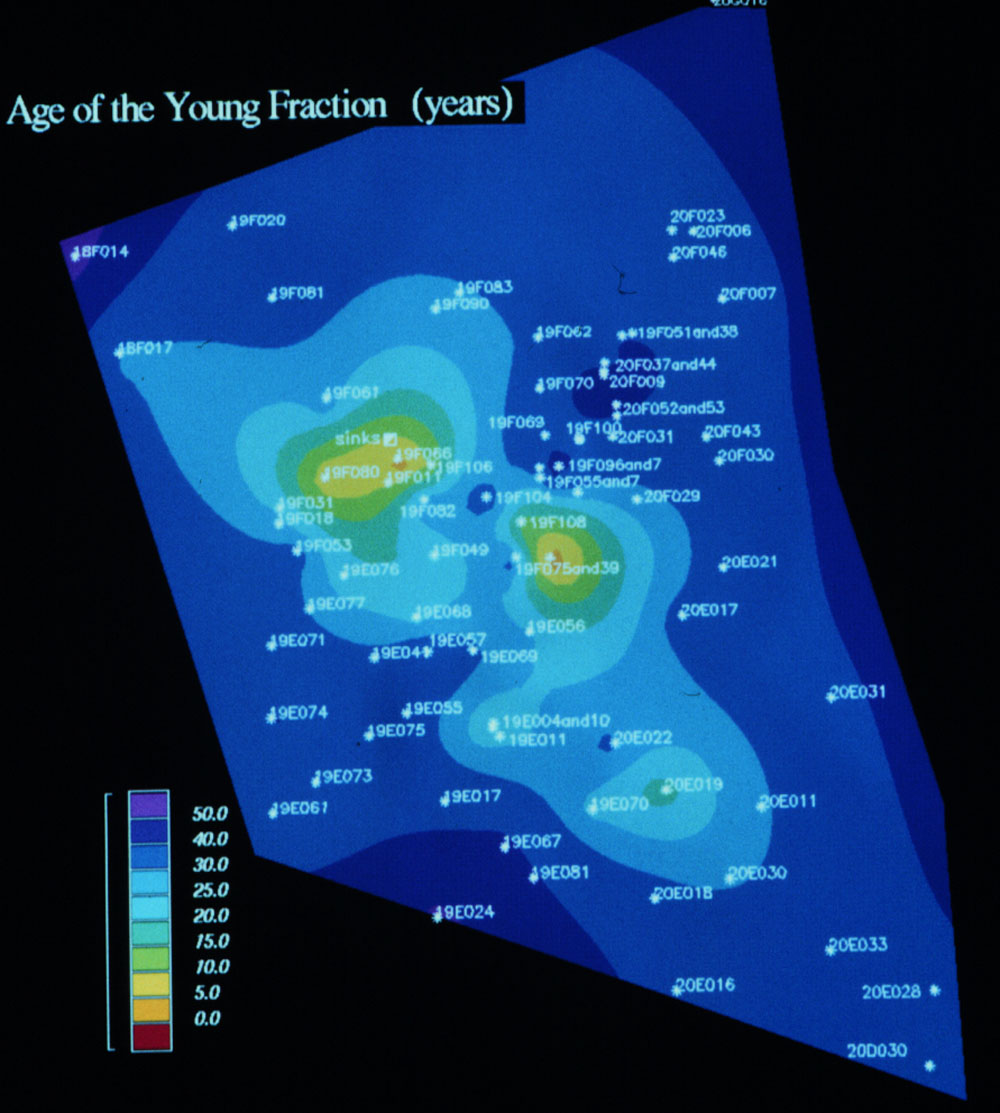
Ages of the young fraction in ground-water mixtures at Valdosta
Publications:
Plummer, L.N., McConnell, J.B., Busenberg, E., Drenkard, S., Schlosser, P., and Michel, R.L., 1998, Flow of river water into a karstic limestone aquifer—1. Tracing the young fraction in groundwater mixtures in the Upper Floridan aquifer near Valdosta, Georgia. Applied Geochemistry, v. 13(8), p. 995-1015.
Plummer, L.N., Busenberg, E., Drenkard, S., Schlosser, P., McConnell, J.B., Michel, R.L., Ekwurzel, B., and Weppernig, R., 1998, Flow of river water into a karstic limestone aquifer—2. Dating the young fraction in groundwater mixtures in the Upper Floridan aquifer near Valdosta, Georgia. Applied Geochemistry, v. 13(8), p. 1017-1043.